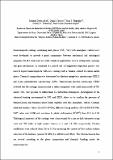Por favor, use este identificador para citar o enlazar a este item:
http://hdl.handle.net/10261/13482COMPARTIR / EXPORTAR:
 SHARE
BASE SHARE
BASE
|
|
| Visualizar otros formatos: MARC | Dublin Core | RDF | ORE | MODS | METS | DIDL | DATACITE | |

| Campo DC | Valor | Lengua/Idioma |
|---|---|---|
| dc.contributor.author | Abad, Manuel D. | - |
| dc.contributor.author | Cáceres, Daniel | - |
| dc.contributor.author | Pogozhev, Yury S. | - |
| dc.contributor.author | Shtansky, D.V. | - |
| dc.contributor.author | Sánchez-López, J.C. | - |
| dc.date.accessioned | 2009-06-04T12:37:56Z | - |
| dc.date.available | 2009-06-04T12:37:56Z | - |
| dc.date.issued | 2009 | - |
| dc.identifier.citation | Plasma Processes and Polymers 2009 | en_US |
| dc.identifier.issn | 1612-8850 | - |
| dc.identifier.uri | http://hdl.handle.net/10261/13482 | - |
| dc.description | 17 pages | en_US |
| dc.description.abstract | Nanocomposite coatings combining hard phases (TiB2, TiC) with amorphous carbon (a-C) were developed to provide a good compromise between mechanical and tribological properties for M2 steels used in a wide variety of applications such as cutting tools, bearings and gear mechanisms. A combined d.c.-pulsed and r.f.-magnetron deposition process was used to deposit nanocomposite TiBC/a-C coatings with a variable content of carbon matrix phase. Chemical composition was determined by electron energy-loss spectroscopy (EELS) and X-ray photoelectron spectroscopy (XPS). Transmission electron microscopy (TEM) revealed that the coatings microstructure is rather amorphous with small nanocrystals of TiC and/or TiB2 (not possible to differentiate by diffraction techniques). Investigation of the chemical bonding environment by XPS and EELS allows us to confirm the presence of titanium-boron and titanium-carbon bonds together with free amorphous carbon. Coatings exhibited hardness values (H) of 25–29 GPa, effective Young modulus (E*) of 310-350 GPa, H/E* ratios over 0.080 and resistance to plastic deformation (H3/E*2) from 0.15 to 0.20. Tribological properties of the coatings were characterized by a pin-on-disk tribometer using steel and WC balls at high contact stresses (1.1 and 1.4 GPa respectively). Friction coefficients were reduced from 0.6 to 0.2 by increasing the content of free carbon without reduction of the hardness (around 28 GPa), by self-lubricant effects. The tribomechanical data are revised according to the phase composition and chemical bonding inside the nanocomposites. | en_US |
| dc.description.sponsorship | The authors are grateful to the Spanish Ministery of Science and Innovation (projects nº MAT2004-01052, MAT2007-66881-C02-01 and CONSOLIDER CSD2008-00023) and European Union (NOE EXCELL NMP3-CT-2005-515703) for financial support. | en_US |
| dc.format.extent | 284827 bytes | - |
| dc.format.mimetype | application/pdf | - |
| dc.language.iso | eng | en_US |
| dc.publisher | John Wiley & Sons | en_US |
| dc.rights | openAccess | en_US |
| dc.subject | magnetron sputtering | en_US |
| dc.subject | TiBC coatings | en_US |
| dc.subject | EELS | en_US |
| dc.subject | XPS | en_US |
| dc.subject | mechanical properties | en_US |
| dc.title | Bonding structure and mechanical properties of Ti-B-C coatings | en_US |
| dc.type | artículo | en_US |
| dc.description.peerreviewed | Peer reviewed | en_US |
| dc.type.coar | http://purl.org/coar/resource_type/c_6501 | es_ES |
| item.openairetype | artículo | - |
| item.grantfulltext | open | - |
| item.cerifentitytype | Publications | - |
| item.openairecristype | http://purl.org/coar/resource_type/c_18cf | - |
| item.fulltext | With Fulltext | - |
| item.languageiso639-1 | en | - |
| Aparece en las colecciones: | (ICMS) Artículos | |
Ficheros en este ítem:
| Fichero | Descripción | Tamaño | Formato | |
|---|---|---|---|---|
| bonding.pdf | 278,15 kB | Adobe PDF |  Visualizar/Abrir |
CORE Recommender
Page view(s)
367
checked on 19-abr-2024
Download(s)
474
checked on 19-abr-2024
Google ScholarTM
Check
NOTA: Los ítems de Digital.CSIC están protegidos por copyright, con todos los derechos reservados, a menos que se indique lo contrario.
